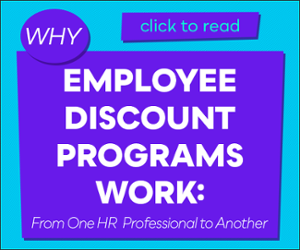Human resources professionals, the spotlight is yours.
Hiring is becoming more and more of a challenge.
Engaging employees is gaining steam as a necessary business investment.
Executives are feeling the pain of employee churn.
90% of executives said keeping new hires is an issue in their organizations (Korn Ferry)
Even with health insurance gobbling up most of the budget, everyone is waking up to the power of employee perks to influence each of these challenges.
Right in the middle of those challenges sits HR, who holds the biggest position of influence when it comes to benefits and perks.
It’s your time to put forth your best proposal.
It’s time to go out and grab that headliner benefit that’s going to be the first item mentioned in the “Best Companies to Work For” awards you’ll receive.
Now is when you can propose the corporate perk that new hires cite when they turn in two week notices at their current workplaces.
But...what exactly is that perk?
Do you have any ideas? Or at least, realistic ideas, assuming custom oil paintings aren’t going to get approved by your executive team?
You can brainstorm and search online for ideas all day. You can research what your competitors are doing, too. Both are necessary.
An even better idea is to create a system to gather and assess ideas from those who'll be most affected by changes to your benefits package: employees.
Here’s how to pull valuable, impactful benefit ideas from your own employees, evaluate those ideas, and build excitement among the team.
Step 1: Get People Talking
Certain employees will be happy to knock on your door and tell you all about their lavish perk ambitions. The rest, you’ll have to ask.
- Create a Survey
Go old school and hand out paper ballots, or create a free survey in a couple of minutes on SurveyMonkey. However you do it, be sure to offer a few specific ideas to choose from as well an an open field for employees to offer their own original ideas.
- Form a Trusted Panel
Select a handful of top employees (not necessarily managers) from each department of your company to join a benefit panel. Get this group together regularly to talk about what perks are working and what others may be needed.
- Office Chatter
Who needs a formal process when you can just stop employees in the hallway and chat them up? Ask them if they’ve used a certain perk, and use that as a jumping point to get to what perk they really want.
Employee input is essential because they’re the ones who’ll benefit most from any changes you make. It also strengthens your case when presenting a new perk to your executive team.
Step 2: Evaluate
Now that you have a big list of ideas, whittle them down to a few realistic options.
You have to be ruthless - the goal isn’t to move forward with the most desired perk, but the most desired perk you can afford, get approved, and drive results from.
Use these five criteria to put your proposed benefits to the test before you place them in front of your executive overlords:
- Value
Can you afford this benefit? And does it have a return that makes the investment worthy in the first place?
Another question to ask here is if the benefit can be offered on a voluntary basis. Be leery of adding too many voluntary options though - they can sometimes do more harm than good.
- Viability
Is this benefit realistic? You can afford virtual working arrangements, for example, but what’s the likelihood your executive team will sign off on it? If they do, will managers in the company be resentful? Will they be able to adjust without a great deal of effort and whining?
Don’t be afraid to push forward with a bold, unique proposal, but be realistic about what the organization can handle and what it isn’t ready for.
- Ease of Implementation and Management
Is this a benefit your primary broker already offers and can manage on your behalf? Or is this corporate perk going to be laborious and time-intensive for you to manage?
Even if a benefit is cheap it doesn’t mean it’s free. Not when you or your benefits manager is devoting an inordinate amount of time managing it.
This is one area in particular where you really, really need an attentive benefits partner (not just a vendor).
- Cultural Fit
Does this perk fit with your company’s purpose? Does it make sense within the scope of the personalities that comprise your team and culture?
This is important. In adding an employee benefit that’s appealing to those you want to attract, you may alienate the people already in your company. Start from within first, and add benefits that your best employees will love.
- Purpose
Imagine your company with this benefit a year from now. What’s the outcome? What’s the aim and likely result of giving it to your team? And is there a smarter alternative that can achieve the same goal?
Step 3: Report Back
Now that you’ve taken your big list of ideas and whittled it down to a few great options, take time to loop in the employees who contributed.
As much as you can, share with employees why their ideas did or didn’t move forward. Let them know you valued their input.
The big goal here is to encourage more dialog. Whether it’s benefits or talking through a workplace issue, you always want employees to see you as a trusted partner in their careers.
Be Bold and Confident
It’s good to create a system, but don’t let it get in the way of taking a big step forward with your employee benefits package.
After all, even the highest executives are waking up to the new realities of working and maximizing the talent in an organization. Turnover and failure to recruit are costing companies billions.
Salaries aren’t going to differ all that much. The real differentiation for potential employees is going to come in the special benefits and perks an employer offers.
And that’s where you come in. You have the ear of the company. Let them hear the news of the awesome benefit you're going to give them all.




